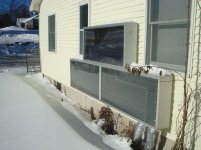dmccarty
Super Star Member
I saw these heaters in Northern Tool a while ago. Figured if we ever built our garage we would have to be able to integrate this type of solar heating into the building. Too bad there was no way to do this in our house since we have brick and we are not going to be cutting through the wall...
Then I started thinking.

We do have a six inch PVC pipe that runs under the slab to bring combustion air to the back of the wood stove. The outside ending of the pipe is on the south side of the house. The house takes advantage of passive solar and we have a gravel walkway on the south side of the house.
Sooo, we could build a collector and use the six inch pipe to pump hot air into the house but we have no way to get cool inside air to the box. And we would have to use a fan to push the air. The house has a roof over hang that lets in the winter sun but keeps out the summer sun. The gravel does get warm even during the winter. Some of the performance data I have seen on these things seems to be showing a 30-40 degree temperature rise. Seems like worst case using outside air we would be pushing 60-70 degree air into the house instead of 20-30 degree air being sucked in by the fire.
Has anyone ever done something like this?
The only other way we could use this technology would be to have the box run up to the eaves and then duct the air into our ceiling. The problem is return air. We would still be stuck using either outside make up air or have to suck in warm air from the ceiling. I suppose we could run ducts to the north side of the house....
Does anyone know of any limits on the duct runs and duct size?
Later,
Dan
Then I started thinking.
We do have a six inch PVC pipe that runs under the slab to bring combustion air to the back of the wood stove. The outside ending of the pipe is on the south side of the house. The house takes advantage of passive solar and we have a gravel walkway on the south side of the house.
Sooo, we could build a collector and use the six inch pipe to pump hot air into the house but we have no way to get cool inside air to the box. And we would have to use a fan to push the air. The house has a roof over hang that lets in the winter sun but keeps out the summer sun. The gravel does get warm even during the winter. Some of the performance data I have seen on these things seems to be showing a 30-40 degree temperature rise. Seems like worst case using outside air we would be pushing 60-70 degree air into the house instead of 20-30 degree air being sucked in by the fire.
Has anyone ever done something like this?
The only other way we could use this technology would be to have the box run up to the eaves and then duct the air into our ceiling. The problem is return air. We would still be stuck using either outside make up air or have to suck in warm air from the ceiling. I suppose we could run ducts to the north side of the house....
Does anyone know of any limits on the duct runs and duct size?
Later,
Dan
